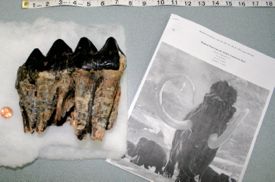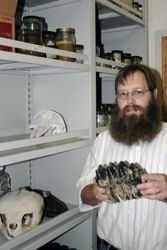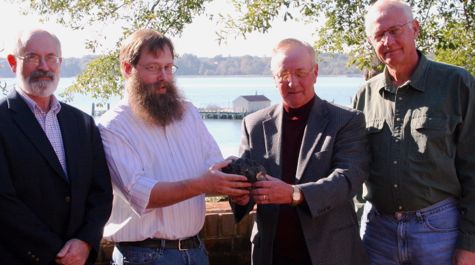VIMS receives mastodon tooth
Mr. Irvin Shackelford of Saluda has donated a mastodon tooth to VIMS on behalf of his family and late father Raymond Shackelford, a long-time charter boat captain out of Bena.
The elder Shackelford was given the tooth in the early 1980s by Eddy Lemon, an acquaintance who worked as a deckhand on a local scallop boat. Lemon had recovered the tooth from a scallop dredge off the coast of New Jersey.
Irvin Shackelford says the tooth—an 8-inch molar—was one of his father’s prized possessions, which he displayed on the mantle in his den along with a fossil clamshell. “He always said he wanted VIMS to have it when he passed on,” says Shackelford.
 VIMS researcher Dr. Eric Hilton, who specializes in vertebrate evolution and curates the vertebrate collection where the tooth will be housed, says the tooth is unusual in the preservation of both crown and roots.
VIMS researcher Dr. Eric Hilton, who specializes in vertebrate evolution and curates the vertebrate collection where the tooth will be housed, says the tooth is unusual in the preservation of both crown and roots.
“It’s more common to find fossil teeth with the just the crown preserved,” says Hilton. The grinding surface of a tooth is typically covered with heavy enamel to help it resist abrasion during chewing, whereas roots are typically of lower density bone.
Whereas concerns about global warming focus on the risk of rising sea level, this tooth and others like it are proof positive that sea level can also drop—mastodon and mammoth teeth have been dredged from the seafloor in waters as deep as 300 feet.
A copy of a 1967 article from Science magazine that accompanied Shackelford’s gift documents 41 specimens of mastodon and mammoth teeth that had been recovered from the Atlantic continental shelf by commercial anglers. The average depth of recovery was 118 feet, the deepest may be 390 feet.
The fossil teeth are often found in association with intact peat beds, showing that they had been recovered from where the prehistoric elephants lived and died, rather than being washed to sea after death.
Geologic evidence suggests that sea level at the height of the last ice age 18,000 years ago was 300-400 feet lower than today, as water evaporated off the ocean and became frozen into the vast ice sheets.
Hilton estimates the tooth to be about 10-12,000 years old, when the ice caps were beginning to melt rapidly. At that time, sea level was 130 to 200 feet lower than present, and large portions of the current continental shelf were a flat, marshy lowland across which mastodons, mammoths, and other prehistoric animals roamed.
 “That would be wild to see,” says Hilton, “15-foot tall elephants wandering off the coast of New Jersey.”
“That would be wild to see,” says Hilton, “15-foot tall elephants wandering off the coast of New Jersey.”
The large cusps along the tooth’s upper surface define it as a mastodon, says Hilton. “Mastodons have 4 to 5 pairs of cusps along the upper surface of the tooth, whereas mammoths have a series of enamel ridges.”
Both prehistoric elephants were herbivores, but mastodons were browsers that ate coarse, brushy materials. Mammoths grazed on grasses.
Hilton says the discrete cusps of the mastodon tooth are a primitive feature, suggesting that mastodons split off earlier in elephant evolution. Both mastodons and mammoths were largely extinct by the end of the last ice age about 10,000 years ago, though some relict populations of dwarf mammoths survived on Arctic Islands until a few thousand years ago.
Though similar in outward appearance (both were “woolly”), mastodons and mammoths are readily distinguished by differences in teeth, bones, and tusks.


